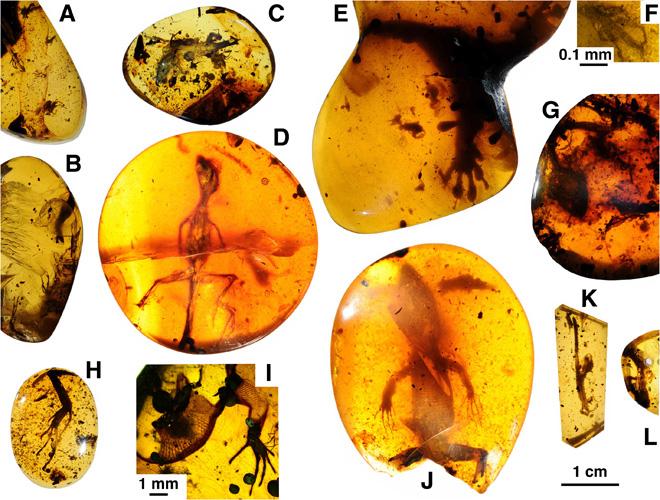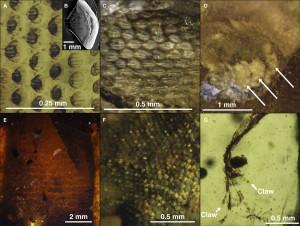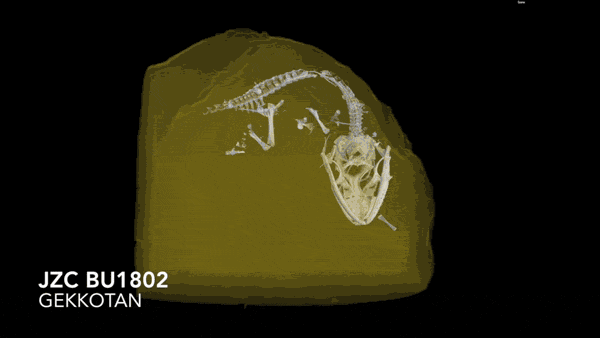3D Photomicrography Helped Identify and 3D Print Replica of Oldest Chameleon Fossil Ever Found Encased in Amber
I’m sure that we’ve all seen Jurassic Park at this point and are more than familiar with the concept of ancient creatures preserved inside of fossilized tree resin, which today we call amber. While the ability to extract dinosaur DNA from mosquitoes trapped in this amber is pure science fiction, it is actually very common to find small insects, plant matter and animals encased and near perfectly preserved. In fact, a great deal of what we actually know about prehistoric ecosystems comes from fossils of this nature. Amber can often act as a window into the past and is virtually the only way that we know what kind of tiny animals and insects lived with the dinosaurs.
99 million years ago, in an area of the world that we now call Myanmar, a tiny juvenile lizard took a wrong turn and got itself stuck in the sticky resin of a coniferous tree. The lizard ended up completely encased in the gooey material, which hardened over hundreds of thousands of years and kept the little dime-size chameleon almost perfectly preserved. It turns out that this fossil is 78 million years older than the previous oldest specimen ever found, and along with 11 more ancient, amber-encased fossil lizards, has given scientists a look into pre-history that they have never had before.
Despite their age, scientists had not had the chance to study the 12 remarkable amber fossils because they were part of a private collection. However, they were recently donated to the American Museum of Natural History where it was discovered exactly how special they were. Because of their small size, it wasn’t easy to identify exactly what they were, but Edward Stanley, a postdoctoral herpetology student from the Florida Museum of Natural History, used some modern technology to not only identify many of the subjects, but get a closer look at fossilized lizards than anyone had ever managed before.
Stanley used micro-CT technology, also called photomicrography, to digitally capture the lizard anatomies and actually reconstruct any decayed or missing parts of the fossil. A micro-CT is a device that uses x-rays to capture a physical object in easy to manage cross-sections that can be assembled to create a detailed 3D model without damaging the object being scanned. It is capable of capturing a remarkable amount of data from even the smallest objects, and with advances in software, the data can easily be converted into 3D printable models. The high-resolution 3D scans resulted in all sorts of new insights about the evolutionary origins and trajectories of many prehistoric lizard family groups.
“These fossils tell us a lot about the extraordinary, but previously unknown diversity of lizards in ancient tropical forests. The fossil record is sparse because the delicate skin and fragile bones of small lizards do not usually preserve, especially in the tropics, which makes the new amber fossils an incredibly rare and unique window into a critical period of diversification. Usually we have a foot or other small part preserved in amber, but these are whole specimens—claws, toe pads, teeth, even perfectly intact colored scales. I was familiar with CT technology, so I realized this was an opportunity to look more closely and put the lizards into evolutionary perspective,” explained Stanley.
Of the 12 new specimens that Stanley is examining he has found 3 of them to be in excellent condition: a gecko, an archaic lizard and the nearly 100-million-year-old chameleon. The fossils reveal that the tropical forest ecosystem of the Cretaceous period was just as diverse in life, especially small lizards, as jungles similar in temperament found at the equator are today. Additionally, the fact that these fossilized lizards still have modern relatives living today proves the impressive stability of tropical forests. The three lizard fossils that Stanley was able to identify as distinct species will need more study before they can be officially named and described in detail, but he has written about then in a new study that he co-authored on the specimens that he published in Science Advances.
“These exquisitely preserved examples of past diversity show us why we should be protecting these areas where their modern relatives live today. The tropics often act as a stable refuge where biodiversity tends to accumulate, while other places are more variable in terms of climate and species. However, the tropics are not impervious to human efforts to destroy them,” Stanley says.
Some of the incredible details that were preserved were features that rarely, if ever, get seen by modern scientists. The preserved lizards include scales, skin that still has visible coloring and even actual soft tissue. The gecko even has visible adhesive toe pads that reveal that it had the modern descendants’ climbing ability far earlier in the evolutionary timeline than previously thought. Stanley also believes that these fossils suggest that the long-held belief that chameleons got their start in Africa may not be as accurate as previously presumed.
You can see a brief video of some of the highly details micro-CT scans rendered in 3D below. What do you think of the processes employed here? Discuss in the 3D Scans & Lizard Fossils forum over at 3DPB.com.
Subscribe to Our Email Newsletter
Stay up-to-date on all the latest news from the 3D printing industry and receive information and offers from third party vendors.
You May Also Like
3D Printing Unpeeled: New Arkema Material for HP, Saddle and Macro MEMS
A new Arkema material for MJF is said to reduce costs per part by up to 25% and have an 85% reusability ratio. HP 3D HR PA 12 S has been...
3D Printing News Briefs, January 20, 2024: FDM, LPBF, Underwater 3D Printer, Racing, & More
We’re starting off with a process certification in today’s 3D Printing News Briefs, and then moving on to research about solute trapping, laser powder bed fusion, and then moving on...
3D Printing Webinar and Event Roundup: December 3, 2023
We’ve got plenty of events and webinars coming up for you this week! Quickparts is having a Manufacturing Roadshow, America Makes is holding a Member Town Hall, Stratafest makes two...
Formnext 2023 Day Three: Slam Dunk
I’m high—high on trade show. I’ve met numerous new faces and reconnected with old friends, creating an absolutely wonderful atmosphere. The excitement is palpable over several emerging developments. The high...





































